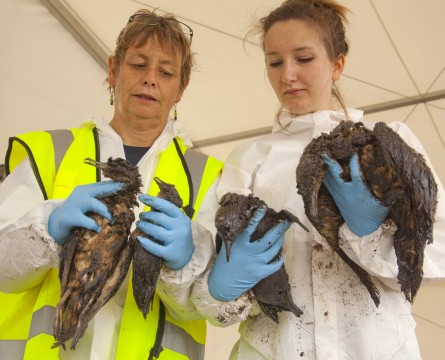Tarred and feathered
Blogger: Forest & Bird’s Seabird Conservation Advocate, Karen Baird
For the next few days, I am going to be based at the Oiled Wildlife Response Unit identifying the feathered victims of the oil spill that occurred over a week ago.

Forest & Bird's Seabird Advocate examines a dead bird at the Oiled Wildlife Response Unit in Tauranga. Photo Kim Westerskov
This grim cargo is being carried ashore at an alarming rate and already we have identified over a thousand birds – some of which are rare and threatened birds, such as the wandering albatross.
After receiving a safety briefing, a high vis vest and an induction from my colleague Al Fleming, I was set to working through the bags and bags of birds that were awaiting identification.
It was devastating to see so many little bodies completely covered in sticky black tar-oil.
Working alongside me yesterday was a team of five bird identifiers led by Te Papa’s Colin Miskelly.
Colin said to forget normal seabird identification* because we were dealing with birds that appeared to be just sticky bunches of mangled feathers with no visible colour.
The task of identification was down to the basics. Colin ably outlined the main differences of what would normally be an easy identification job and we set about picking our way through the victims.
I was shocked by the numbers of birds – so many tiny diving petrels – breeding birds all now with tiny chicks to be fed who will starve back on the colony.
I was alarmed too by the numbers of Buller’s shearwaters (no: 68) – a bird that only breeds on the Poor Knights Islands.
It kept on showing up again and again, and was one of the most common species to be identified after common diving petrel and fluttering shearwater.
There was no sign of the beautiful plumage of this our most attractive endemic shearwater, just matted feathered cold bodies.
We will be keeping an eye out for data loggers which have been placed on some of these birds by Graeme Taylor from the Department of Conservation who is studying the movements of these birds.
Perhaps the saddest sight of the day was of a majestic wandering albatross laid out on the blue tarp. It was mostly dark indicating it was a juvenile.
Because it was only lightly oiled the vet decided to do a necropsy. We discovered it was a boy who was in poor condition with little muscle mass before he became oiled – the oil would have ended any hope of survival.
As the seabird capital of the world, New Zealand is home to over half of the world’s albatross – our guardianship is crucial. And bit by bit, we’ve made some changes to improve our seabirds’ survival.
In the area adjacent to the spill-zone there are two marine reserves and many offshore islands that are pest free to ensure these birds are safe and well fed.
Indeed on a good day in the Bay of the Plenty, the sea sky is bird-filled. It’s full to bursting. For now though it seems the skies are emptied and the sea delivers a thousand tiny sadnesses.
*I’m used to seeing them floating carelessly over the ocean
Last night Colin Miskelly sent a breakdown of the first 801 birds that were identified. They were:
Mallard/hybrid duck 2
Little penguin 20
Antipodean wandering albatross 1
White-capped mollymawk 1
Northern giant petrel 2
Cape petrel 4
Grey-faced petrel 1
Mottled petrel 1
Antarctic prion 3
Fairy prion 12
Blue petrel 13 (perhaps the most surprising species to be affected at all,
let alone 13 of them)
Buller’s shearwater 92
Flesh-footed shearwater 3
Sooty shearwater 13
Fluttering shearwater 198
Little shearwater 15
Common diving petrel 458
White-faced storm petrel 38
Australasian gannet 7
Pied shag 4
Little black shag 1
Spotted shag 2
Pukeko 1
Bar-tailed godwit 1
Mandy
